Comet 17P/Holmes has been intriguing astronomers since the end of October, when its sudden outburst in brightness, the biggest in the history of comet research, was observed. Scientists from Nicolaus Copernicus University in Torun in Poland have published a series of images illustrating the evolution of the comet.
Astronomers from the Torun Centre for Astronomy of Nicolaus Copernicus University in Torun (Poland) pointed their 0.9 m optical telescope at the comet. At optical wavelengths, they obtained many images. The first images were obtained on 26th October, three days after the outburst. The following images were taken on 2nd, 8th, 10th November and finally on 15th November.
By composing these photos into a sequence of images using the same scale in each picture, the increase in the size of the comet's envelope can be seen. The comet's envelope on November 15th was seven times bigger than that of 26th October. On the website of the Torun Centre for Astronomy a movie presenting the comet, obtained with 0.6 m telescope, is available.
17P/Holmes is now 1.6 astronomical units (nearly 250 million kilometers) from the Earth. The comet-Earth distance is increasing. The next return of Comet Holmes is expected in about 7 years' time.
"We have been doing observations to detect fast changes in brightness of the nucleus, over a range of minutes or even seconds. Our data do not show changes of brightess on this time scale during one night session." said Ernest Swierczynski, student and one of the observers of the comet from the Nicolaus Copernicus University.
"From experience with similar comets, astronomers know that after a rapid outburst in brightness during about 2.5 days, a comet should then return back to its previous brightness in about 20-30 days. 17P/Holmes does not behave according to this rule, it is still bright, even though it is almost one month since the outburst (the comet's outburst happened around 23th October)." said Dr Maciej Mikolajewski from Nicolaus Copernicus University.
The comet can be seen in Perseus, near the brightest star of this constellation. 17P/Holmes' brightness was 3 magnitudes on 15th November. It is recommended to watch it with binoculars on a non-cloudy night.
The Torun Centre for Astronomy is an astronomical observatory of Nicolaus Copernicus University, located 10 km north of Torun city in central Poland. Among its telescopes are 0.6 m and 0.9 m optical telescopes and 15 m and 32 m radiotelescopes. Nicolaus Copernicus University in Torun is one of the biggest universities in Poland, with about 40,000 students.
More information:
* Torun Centre for Astronomy - images of the comet
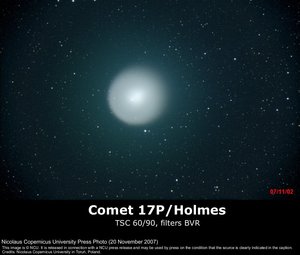
|
| ©Nicolaus Copernicus University in Toruń. |
| Photo of Comet 17P/Holmes taken on 2.11.2007 with the TSC 60/90 telescope (0.9 m diameter). The image is created from photos in the B, V and R filters. |
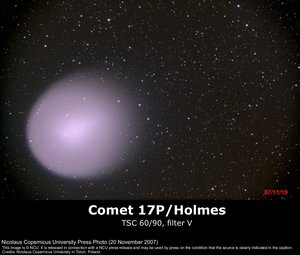
|
| ©Nicolaus Copernicus University in Toruń. |
| Image of Comet 17P/Holmes taken in V filter on 10.11.2007 with the TSC 60/90 telescope (0.9 m diameter). |
Translation: Krzysztof Czart, Boud Roukema
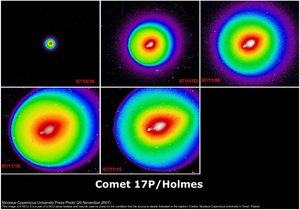
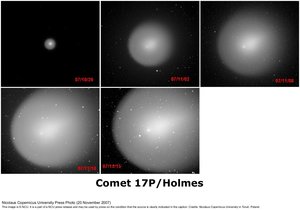
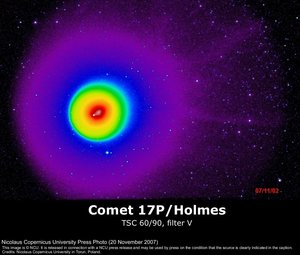



Reader Comments
to our Newsletter